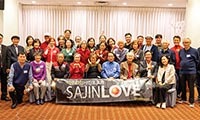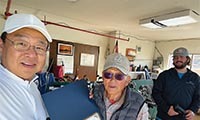Plight of Comfort Women Depicted in Picture Book
▶ By Chung Hye-jean
It is one in a collection of about 90 paintings and drawings recently published in a book. The works were created during a period of seven years by six former Japanese military comfort women living at the "House of Sharing" in Kwangju, Kyonggi-do. Titled "Unblossomed Flower," the 200-page book has been printed in three languages — Korean, English and Japanese.
"Comfort women" is a euphemism for the sex slaves who were raped by Japanese soldiers at military camps during World War II. There were an estimated 50,000 to 300,000 comfort women.
They were young women, usually in their teens, some as young as twelve. A large number came from Korea, but others also came from other countries occupied by the Japanese army, such as China and the Philippines.
The women were forced to have sex with 10 to 30 soldiers a day. Many were tortured or killed in the Japanese military camps. Others caught venereal diseases or got pregnant.
Abandoned after the war, some comfort women were killed by the retreating Japanese military, while others committed suicide out of shame. Unable to make the return trip home, some women had to stay behind in a foreign country.
Those who did return home lived in poverty and deep shame, suffering from permanent physical and emotional scars that would never heal. Because of their painful past, many comfort women never married, and lived in solitude.
For decades, many women could not express their pain in words, as it would dishonor not only themselves, but also their families. It was not until the early 1990s that these women started to speak out and reveal their heart-wrenching stories about the heinous crimes committed by the Japanese army and the hardships they endured.
At age 67, the first former comfort woman to testify in public was Kim Hak-soon. She came forward in August 1991 and passed away in December 1997.
Former comfort women are often called "halmoni," an affectionate term meaning "grandmother" in Korean.
In 1992, several former comfort women moved in to the House of Sharing for shelter and support. Founded in 1992 with support from Buddhist and social organizations, it was originally situated in Sokyo-dong, Seoul. It moved to its current location in Kwangju-gun, Kyonggi-do in December 1995. Today 11 halmonis and a staff of seven reside at the shelter.
In February 1993, the halmonis living there started receiving art therapy to express their feelings. They learned how to paint under the instruction of artist, Lee Kyung-shin, who volunteered to teach them each week. For three years, the class focused on assuaging the wounds buried deep inside them and turning the pain and sorrow they had encountered as war victims into art.
Imbued with a disturbing, touching power, these paintings portray the testimony of the women. The sketches and paintings vividly convey their feelings of shame, anger and bitterness which remained bottled up till now as well as their quest for justice. Not only does their artwork help to heal their wounds, it plays a key role in publicizing their story as comfort women around the world.
The first exhibition of artwork done by former comfort women was held in 1995 in Tokyo and Nagoya and it evoked a huge response. In 1996, the exhibition toured several places in Korea, such as the Seoul Arts Center.
In 1997 and 1998, the artworks of the halmonis, entitled the "Grandmothers’ Painting Exhibition," were invited once more to Japan at the request of Japanese citizens’ organizations. The exhibition toured 28 different cities, such as Tokyo, Kyoto and Osaka.
The exhibition helped the Japanese society become aware of this issue. After seeing the exhibition, many Japanese were struck by the pain suffered by the victims and became involved in their plight. About 150 Japanese visitors come to the House of Sharing every month with gifts and apologies, some even staying to cook and do housework.
At present, the exhibition is being shown in the U.S. and Canada for the first time. Since Sept. 22, the exhibition has toured Chicago, New York, Los Angeles and is currently on display in Philadelphia. Afterwards, it will head for Toronto and end its tour in San Francisco, where the exhibition will continue until Dec. 3.
The tour, titled the "Quest for Justice: The Story of Korean ‘Comfort Women’ as Told Through Their Art," was sponsored by the House of Sharing and the Historical Museum on Sexual Slavery by the Japanese Military.
"Silence Broken — Korean Comfort Women," a 57-minute documentary, is also shown along with the exhibition. The documentary discloses the harrowing testimony of what actually happened to Korean comfort women during the war.
Two former comfort women, Kim Soon-duk, a resident of the House of Sharing, and Hyejin, a 35-year-old Buddhist monk, who is also the executive director of the House of Sharing, are touring with the exhibition.
One third of the acrylic paintings on display are by Kim, who drew "Stolen Away." Simple and unaffected, yet poignant, her paintings show scenes of her life before and after she was forced into sexual slavery.
Now 80, Kim Soon-duk was recruited in 1937, at age 17, with other Korean girls for what she was told would be factory work in Japan.
For three years, Kim was raped by as many as 40 soldiers a day at her "comfort station" outside Shanghai, China. After a serious illness, she was allowed to return to Korea in 1940.
Too ashamed to go back home, Kim led a difficult life working as a housekeeper and running small businesses. For years, she told nobody about what had happened to her, including her mother, late husband and three children.
In 1992, she moved into the House of Sharing, where she keeps busy to block the memories of her past experiences. She is still haunted by nightmares and suffers mild internal bleeding from her injuries.
There were demonstrations in front of the Japanese consulates in the U.S. cities where the exhibitions were held in support of the "Weekly Wednesday Demonstrations" held in front of the Japanese Embassy in South Korea every Wednesday since 1992.
At the demonstration, protestors demand the Japanese government admit to their war crimes, offer an official apology and pay reparations to the victims. The Japanese government continues to deny the accusations and still has not offered an official apology.
In September, former comfort women visited Washington, D.C. to file a lawsuit in a federal court against the Japanese government for forcing women into sexual slavery. They demanded that the Japanese government be held legally responsible and be punished for their war crimes.
Robinjean9@hotmail.com
스마터리빙
more [ 건강]
[ 건강]이제 혈관 건강도 챙기자!
[현대해운]우리 눈에 보이지 않기 때문에 혈관 건강을 챙기는 것은 결코 쉽지 않은데요. 여러분은 혈관 건강을 유지하기 위해 어떤 노력을 하시나요?
 [ 건강]
[ 건강]내 몸이 건강해지는 과일궁합
 [ 라이프]
[ 라이프]벌레야 물럿거라! 천연 해충제 만들기
 [ 건강]
[ 건강]혈압 낮추는데 좋은 식품
[현대해운]혈관 건강은 주로 노화가 진행되면서 지켜야 할 문제라고 인식되어 왔습니다. 최근 생활 패턴과 식생활의 변화로 혈관의 노화 진행이 빨라지고
사람·사람들
more
“취미생활로 다진 친목… 선후배들과 만든 모교사랑”
사진러브한인 사진 동호회 사진러브(회장 크리스 고)는 13일 용수산에서 송년모임을 갖고 한 해를 마무리하는 뜻깊은 시간을 가졌다. 이날 모임에…

[홀인원] 이상원 박사
일반외과 전문의 이상원(왼쪽) 박사가 지난 9일 뉴포트비치 소재 골프장 9번 홀(152야드)에서 레스큐 클럽으로 친 샷이 그대로 홀에 빨려 들…
[송년행사 게시판] 재미시인협회
재미시인협회(회장 지성심)는 오는 20일 오후 4시 가든스윗호텔에서 한 해를 마무리하며 동인지 ‘외지’ 제35집 출판 기념회와 ‘제23회 재미…
[송년행사 게시판] 향군단체 연합
6.25 참전유공자회와 대한민국 육군협회 등 남가주 지역 향군 단체 연합은 19일 오전 11시30분, 용궁에서 송년 행사를 개최한다. 드레스코…
[송년행사 화보] “이웃과 함께 나누고 지인과 함…
KYCC13일 윌튼 플레이스 초등학교에서 열린 ‘한인타운청소년회관(KYCC) 홀리데이 카니발’이 성황리에 막을 내렸다. 올해는 KYCC 창립 …
많이 본 기사
- ‘유세방불’ 트럼프 “관세가 물가 올린다더니 인플레 수년來 최저”
- 30년 만에 ‘금리 0.5%’ 허문 일본
- 신민아♥김우빈, 결혼식 날 웨딩 사진 첫 공개..눈부신 투샷
- 개명 하루만에 케네디센터 외벽에 ‘트럼프’ 추가…위법 논란도
- 이 대통령 “피도 눈물도 없는 금융사… 공적 책임의식 충분한가”
- 이 대통령, “불법촬영물, 초국가 범죄 대응본부 수사”
- 대북제재 완화 시그널… 이 대통령, 통일부 역할 주문
- 명문대 조기전형 합격률 속속 발표
- 대법 예규 후속절차, 22일 ‘형사부 증설’ 판사회의… 서울고법 ‘내란 전담재판부’ 설치 돌입
- 오바마케어 보조 확대 연장 종료 유력
- “루비랑 데이트”..송혜교의 따뜻한 연말
- ‘80세’ 선우용여, 대세 유튜브 수… 1
- “개인 부동산 취득, 법카 사적 유용” 박수홍 친형 구속 이유 보니
- 뉴욕-뉴저지 다리· 터널 통행료 또 오른다
- 시민권 박탈 착수⋯매달 200명 1
- ‘김혜성도 넘었다’ 6년 120억 결… 1
- 故윤석화 빈소에 추모 발길… “하늘에서 좋은 작품 많이 하기를”
- “불공정 행위 걸리면 망하게 대기업 과징금 세게 때려야”
- 금리 인상 ‘엔 캐리(싼 이자로 엔화 빌려 투자)’ 빠져나갈라… 비트코인·환율 ‘출렁’
- “박나래, 주사 이모 약에 내성 생겨..약 떨어지면 연락하라고”
- 구글, 검색결과 크롤링 업체 상대 소송…AI 경쟁사 견제 의도
- 동업자에서 채무자로..MC몽, 차가원… 1
- 尹 소환한 김건희특검, ‘명태균 의혹’부터 6가지 혐의 순차 추궁
- 美, IS 무기고 등 70여곳 공습… “전쟁 시작 아닌 복수 선언”
- 해군, 트럼프 ‘황금함대’ 새 전함 발주… “외국조선사도 활용”
- 각국 AI 패권 경쟁 본격화… 5조달러 시장 선점 총력
- 고환율, 생산자 물가 석달째 오름세
- 법무부, ‘엡스타인문건’ 공개…정재계 추가 연루 증거 나올까
- 트럼프, 화성은 미루고 달부터…머스크… 2
- 북한군, 지난달 MDL 10번 넘었다
- 뉴욕주 차량운전자 벌점 규정 대폭 강화
- [업계] 12월 내내 크리스마스 특별 메뉴 출시
- 테라폼랩스 파산관재인, 테라 가격부양 금융사에 수조원대 소송
- AMRO(아세안+3 거시경제조사기구) “한국 경제 개선세” 내년 1.9% 성장 예상
- “AI 보안으로 클라우드 시장 잡자”…구글, 100억 달러 보안 파트너십
- 파워볼 1등 잭팟 15억 달러로 치솟아
- “트럼프, 강경화 대사에 ‘李대통령과 최고의 협력관계’ 언급”
- “스페이스X, 상장 주관사 선정 착수…모건스탠리 유력”
- [사는 이야기] 요즘 한국은
- 퀸즈장로교회 ‘사랑의 바구니’130개 이웃에 전달
- 위기의 트럼프 “내년봄 최대규모 세금환급”
- 中, ‘트럼프와 합의’ 美대두 수입 … 1
- [삶과 생각] “재미있게 묘사한 오늘날 우리의 삶”
- 아마존, 칩 조직 통합 개발사 본격 변신 포석
- 루비오 국무장관 “韓·日 등 동맹과 약속 훼손 없이 中과 협력 모색”
- 브라운대 총격 용의자 시신 발견… ‘… 1
- 尹, 김건희특검 첫 출석…변호인 “아내 금품수수 몰랐다”
- 美, 베네수 마두로 압박 강화…처제·동서·조카 무더기 제재
- 기아 미국법인, 2026년형 ‘K4 … 1
- 김민선 백악관 자문위원 백악관 연말 파티 참석
1/5지식톡

-
 ☝️해외에서도 가능한 한국어 선생님…
0
☝️해외에서도 가능한 한국어 선생님…
0이 영상 하나면 충분합니다!♥️상담신청문의♥️☝️ 문의 폭주로 '선착순 상담'만 진행합니다.☎️ : 02-6213-9094✨카카오톡ID : @GOODEDU77 (@골뱅이 꼭 붙여주셔야합니다…
-
 테슬라 자동차 시트커버 장착
0
테슬라 자동차 시트커버 장착
0테슬라 시트커버, 사놓고 아직 못 씌우셨죠?장착이 생각보다 쉽지 않습니다.20년 경력 전문가에게 맡기세요 — 깔끔하고 딱 맞게 장착해드립니다!장착비용:앞좌석: $40뒷좌석: $60앞·뒷좌석 …
-
 식당용 부탄가스
0
식당용 부탄가스
0식당용 부탄가스 홀세일 합니다 로스앤젤레스 다운타운 픽업 가능 안녕 하세요?강아지 & 고양이 모든 애완동물 / 반려동물 식품 & 모든 애완동물/반려동물 관련 제품들 전문적으로 홀세일/취급하는 회사 입니다 100% …
-
 ACSL 국제 컴퓨터 과학 대회, …
0
ACSL 국제 컴퓨터 과학 대회, …
0웹사이트 : www.eduspot.co.kr 카카오톡 상담하기 : https://pf.kakao.com/_BEQWxb블로그 : https://blog.naver.com/eduspotmain안녕하세요, 에듀스팟입니다…
-
 바디프렌드 안마의자 창고 리퍼브 세…
0
바디프렌드 안마의자 창고 리퍼브 세…
0거의 새제품급 리퍼브 안마의자 대방출 한다고 합니다!8월 23일(토)…24일(일) 단 이틀!특가 판매가Famille: $500 ~ $1,000Falcon: $1,500 ~ $2,500픽업 & 배송직접 픽업 가능LA…
케이타운 1번가
오피니언
 한영일 / 서울경제 논설위원
한영일 / 서울경제 논설위원[만화경] 웰다잉 인센티브
 캐슬린 파커 워싱턴포스트 칼럼니스트
캐슬린 파커 워싱턴포스트 칼럼니스트 [캐슬린 파커 칼럼] 아이들을 온라인에서 보호하기
 양상훈 수필가ㆍ시인
양상훈 수필가ㆍ시인 [한국춘추] 경제대공황ㆍ제2차 세계대전 승리로 극복한 루스벨트 리더쉽

[왈가 왈부] 고환율에 외환 건전성 완화·서학개미 규제… 미봉책 아닌가요
 수잔 최 한미가정상담소 이사장 가정법 전문 변호사
수잔 최 한미가정상담소 이사장 가정법 전문 변호사 [수잔 최 변호사의 LIFE &] AI 시대 편리함에 안주하지 말자
 김도년 성균관대 건축학과 교수 스마트도시·건축학회장
김도년 성균관대 건축학과 교수 스마트도시·건축학회장 [로터리] 지멘스가 만드는 미래 동네
1/3지사별 뉴스

퀸즈장로교회 ‘사랑의 바구니’130개 이웃에 전달
퀸즈장로교회가 18일 크리스마스를 앞두고 교인들의 정성과 사랑이 듬뿍 담긴 ‘사랑의 바구니’ 130개를 소방서와 경찰서, 요양원, 선교회, 그…
시민권 박탈 착수⋯매달 200명

“이웃 돌보는 여러분이 동역자”
워싱턴성광교회(담임목사 임용우)는 18일 한인단체와 소방서‧도서관 등에 총 2만9천 달러의 성금을 전달했다. 지난 2011년부터 15년째 지역…
소기업 지원에 1천만 달러 투자

위기의 트럼프 “내년봄 최대규모 세금환급”
트럼프 대통령은 17일 “취임 1년 만에 우리는 누구도 상상하지 못한 성과를 이뤄냈다”고 말했다.트럼프 대통령은 동부시간 이날 밤 9시부터 백…
[새해부터 이렇게 달라진다] 최저임금 또 오르고… 유급 병가는 더 확대

오늘 하루 이 창 열지 않음 닫기 




















































.png)


댓글 안에 당신의 성숙함도 담아 주세요.
'오늘의 한마디'는 기사에 대하여 자신의 생각을 말하고 남의 생각을 들으며 서로 다양한 의견을 나누는 공간입니다. 그러나 간혹 불건전한 내용을 올리시는 분들이 계셔서 건전한 인터넷문화 정착을 위해 아래와 같은 운영원칙을 적용합니다.
자체 모니터링을 통해 아래에 해당하는 내용이 포함된 댓글이 발견되면 예고없이 삭제 조치를 하겠습니다.
불건전한 댓글을 올리거나, 이름에 비속어 및 상대방의 불쾌감을 주는 단어를 사용, 유명인 또는 특정 일반인을 사칭하는 경우 이용에 대한 차단 제재를 받을 수 있습니다. 차단될 경우, 일주일간 댓글을 달수 없게 됩니다.
명예훼손, 개인정보 유출, 욕설 등 법률에 위반되는 댓글은 관계 법령에 의거 민형사상 처벌을 받을 수 있으니 이용에 주의를 부탁드립니다.
Close
x